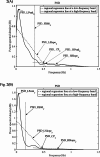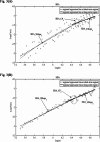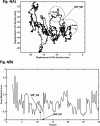Correlation of balance posturographic parameters during quiet standing with the berg balance scale in patients with parkinson's disease
- PMID: 37803250
- PMCID: PMC10557353
- DOI: 10.1186/s12883-023-03386-1
Correlation of balance posturographic parameters during quiet standing with the berg balance scale in patients with parkinson's disease
Abstract
Background: Parkinson's disease (PD) is often clinically associated with posture instability and more easily falling. The Berg balance scale is a clinical indicator commonly used to subjectively evaluate a patient's balance ability. Meanwhile, computerized force platforms have been used in research on postural control. The various parameters obtained from posturography are interpreted to assess balance ability. The present study aims to explore the correlations between posturographic variables and the BBS, and furthermore to efficiently evaluate postural instability and fall risk of early and moderate PD patients.
Methods: A total of 46 PD patients were involved in the experiment. Patients were asked to perform BBS tests and force platform tests under eye open (EO) and eye closed (EC) conditions. The recorded COP signal was analyzed with the time domain statistical method, the frequency domain method of Power Spectral Density (PSD), and structural methods of Stabilogram Diffusion Analysis (SDA), Sway Density Plot (SDP) to retrieve different posturographic variables. The correlation between posturographic variables under EO and EC conditions with BBS was compared statistically. The significantly correlated posturographic parameters were then applied to analyze posturographic differences between different groups: faller vs. non-faller (patients with/without a history of falls in the past 12 months).
Results: Among the different posturographic parameters, the prediction ellipse area, the slope of the regression line at a high-frequency band of PSD in the medial-lateral (ML) direction, the crossover point of the regression lines of SDA in the anterior-posterior (AP) direction, and the distance between successive peaks of SDP had significant correlations with BBS. These selected BBS-related parameters also showed significant differences between faller and non-faller. The selected posturographic parameters can be used as effective indicators to evaluate the balance ability of Parkinson's disease patients.
Keywords: Balance control; Berg Balance Scale; Center of pressure (COP); Parkinson’s disease (PD); Posturography.
© 2023. BioMed Central Ltd., part of Springer Nature.
Conflict of interest statement
The authors declare no competing interests.
Figures





Similar articles
-
Instrumental balance assessment in Parkinson's disease and parkinsonism. A systematic review with critical appraisal of clinical applications and quality of reporting.Front Neurol. 2025 Jan 29;16:1528191. doi: 10.3389/fneur.2025.1528191. eCollection 2025. Front Neurol. 2025. PMID: 39944549 Free PMC article.
-
Dynamic postural balance indices can help discriminate between patients with multiple system atrophy and Parkinson's disease.Front Neurol. 2023 Jan 9;13:1089439. doi: 10.3389/fneur.2022.1089439. eCollection 2022. Front Neurol. 2023. PMID: 36698891 Free PMC article.
-
Dynamic posturography and posturographic training for Parkinson's disease in a routine clinical setting.Gait Posture. 2020 Oct;82:281-286. doi: 10.1016/j.gaitpost.2020.09.013. Epub 2020 Sep 20. Gait Posture. 2020. PMID: 33002838
-
The Use of the Static Posturography to Assess Balance Performance in a Parkinson's Disease Population.Int J Environ Res Public Health. 2023 Jan 5;20(2):981. doi: 10.3390/ijerph20020981. Int J Environ Res Public Health. 2023. PMID: 36673738 Free PMC article.
-
A posturographic procedure assessing balance disorders in Parkinson's disease: a systematic review.Clin Interv Aging. 2018 Nov 12;13:2301-2316. doi: 10.2147/CIA.S180894. eCollection 2018. Clin Interv Aging. 2018. PMID: 30519012 Free PMC article.
Cited by
-
Instrumental balance assessment in Parkinson's disease and parkinsonism. A systematic review with critical appraisal of clinical applications and quality of reporting.Front Neurol. 2025 Jan 29;16:1528191. doi: 10.3389/fneur.2025.1528191. eCollection 2025. Front Neurol. 2025. PMID: 39944549 Free PMC article.
References
-
- Boonstra TA, Kooij HVD, Munneke M, Bloem BR. Gait disorders and balance disturbances in Parkinson’s disease: clinical update and pathophysiology. Curr Opin Neurol. 2008;21:4461–71. - PubMed
-
- Pickering RM, Grimbergen YAM, Rigney U, Ashburn A, Bloem BR. A meta-analysis of six prospective studies of falling in Parkinson’s disease. Mov Disord. 2010;22 13:1892–900. - PubMed
-
- Hubble RP, Silburn PA, Naughton GA, Cole MH. Assessing stability in mild and moderate Parkinson’s disease: can clinical measures provide insight? Gait Posture. 2016;49:7–13. - PubMed
MeSH terms
Grants and funding
LinkOut - more resources
Full Text Sources
Medical
Miscellaneous

